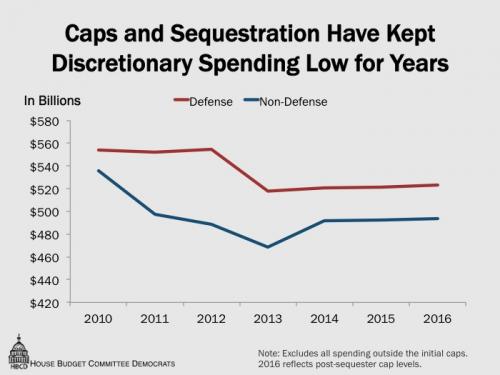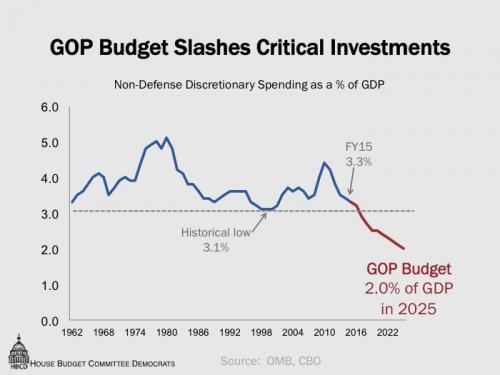Republican Insistence on Sequester-level Spending for Non-Defense Needs is Causing Harm
The time is long overdue for Congress to raise the sequester-level discretionary spending caps. These caps have led to woefully inadequate investment in critical national needs and put us on a path to another government shutdown. Congressional Democrats have asked Republicans for bipartisan negotiations so that Congress can change the current path and address the country's needs in order to help middle-class families as well as those striving to join the middle class. Unfortunately, Republican leadership insists on restraining spending on non-defense needs to the harmful, sequester level this year and to even lower levels in the future. At the same time, Republicans are using a budget gimmick to provide billions of dollars of additional defense funding above the sequester level.
Sequester Caps were Never Intended to Go into Effect
To reduce the deficit, the Budget Control Act of 2011 set annual caps on defense and non-defense discretionary spending through 2021 and also required Congress to develop and enact an additional $1.2 trillion package of deficit reduction. The Act used the threat of what was thought to be unacceptable – the even deeper spending cuts under sequestration – as the impetus for Congress to accomplish the savings in a more responsible way. Unfortunately, Congress could not agree on a package of deficit reduction, so starting in 2013, federal spending has been further capped by sequestration, with defense and non-defense discretionary spending levels far below the original Budget Control Act caps. Congress has slightly raised the post-sequester caps twice since 2011, resulting in discretionary spending being at a virtual freeze from fiscal year 2014 through 2016, even though national needs and costs continue to grow.

Republicans Keep Sequester Cap for Non-Defense but Provide More for Defense
The post-sequester level of funding was meant to be so unrealistically low that Congress would find a better way to reduce the deficit rather than let the sequester take place. Democrats are trying to do just that. President Obama proposed to raise both the fiscal year 2016 defense and non-defense caps by about $37 billion in his budget, but the Republican budget resolution instead uses a gimmick to provide the additional defense funding – using unrestricted war funding for regular defense needs – without providing a penny more for non-defense needs. The picture gets even worse from 2017 through 2025, when the Republican budget abandons the Budget Control Act premise of the sequester producing equal deficit reduction from both defense and non-defense programs; the Republican budget actually cuts non-defense funding by an additional $496 billion below the sequester-level austerity caps. As a share of the economy, funding for strategic non-defense investments in 2025 will fall 35 percent below the lowest level seen in the last 50 years.

What the Non-Defense Sequester Cap Means
The Republicans' decision to keep non-defense funding at the post-sequester level for 2016 is leading to gridlock in enacting appropriations bills. Both the Administration and Congressional Democrats have made clear that they will not support appropriations bills at the low levels mandated by the Republican budget, resulting in gridlock in the appropriations process as the end of the fiscal year looms. Republicans have already proven they are willing to shut down the government to try to get their way, even though that has never succeeded in anything but harming the public by stopping necessary government services.
The House has already passed 6 of the 12 appropriations bills and the House Appropriations Committee has approved the others, making clear which cuts Republicans will make to stay under the fiscal year 2016 post-sequester cap on non-defense funding. Some of their harmful cuts include the following:
Education ―The Republican bill slashes funding for the Department of Education by $2.8 billion below the current 2015 level, eliminating 19 primarily pre-K-12 programs. It provides $1.3 billion less than the President requested for Head Start, potentially providing 570,000 currently enrolled children with less than full-day, full-year services.
Job Training ―At a time when so many Americans are still struggling to find work and others are seeking to improve their skills to grow their paychecks, the Republican bill actually cuts funding for employment and training programs below the current level and by a total of almost $1 billion below the President's request.
Housing ― According to the Administration, the $1.2 billion cut to the President's request for Housing Choice Vouchers in the Republican bill will mean that not only will the 67,000 vouchers lost to the 2013 sequester not be restored but an additional 28,000 existing vouchers will be lost. The Republican bill also provides $295 million less than the President requested for homeless assistance grants, putting more families at risk for homelessness.
Infrastructure ―The Republican transportation funding bill provides $1.2 billion less than the President requested for TIGER grants that allow states and localities to leverage public and private dollars for highway, port, and transit projects. The bill cuts funding for the Federal Aviation Administration facilities and equipment to the lowest level in 15 years, jeopardizing its ability to maintain flying safety. It also cuts transit funding by $161 million below the current level.
Veterans —The Republican bill provides $1.4 billion less than the President requested for the Department of Veterans Affairs (VA), including $600 million less for the Veterans Health Administration. This reduction would negatively impact medical care services for tens of thousands of veterans and reduce VA's ability to activate new and replacement facilities with sufficient staff and equipment and to adequately maintain facility infrastructure. The bill also underfunds the President's request for major VA construction projects by $582 million, preventing building upgrades and renovations, including necessary expansions to medical facilities.
Public Health ― The Republican bill would drastically undermine the important health care coverage, cost, and quality improvements provided by the Affordable Care Act, including rescinding $6.7 billion for innovations in health care delivery and cost reductions, and eliminating a health care improvement agency that contributed to a 17 percent decline in hospital-acquired conditions between 2010 and 2013 that correspond to 50,000 avoided deaths.
Natural Resources ― The Republican bill cuts the Environmental Protection Agency budget by $718 million below the current 2015 enacted level, bringing staff down to the lowest level since 1989 and jeopardizing the agency's work in protecting public health and the environment, ensuring clean air and water, and prohibiting future pollution and cleaning up existing hazards.
Science and Research ― The Republican bill provides $329 million less than the President requested for the National Science Foundation, leading to about 600 fewer grants and affecting almost 8,000 researchers and students.
Public Safety ― The Republican bill provides nearly $400 million less than the President requested for state and local criminal justice assistance programs, including a 25 percent cut to the President's request for the COPS program. The bill cuts funding for the Legal Service Corporation by $152 million below the President's request, denying legal aid to more than 350,000 low-income Americans.